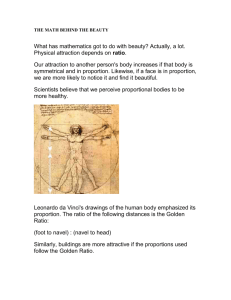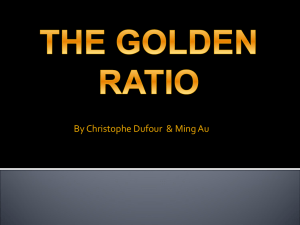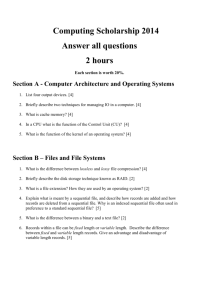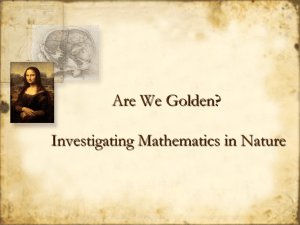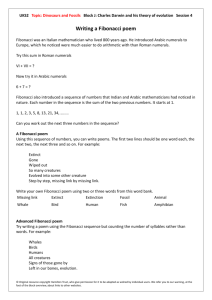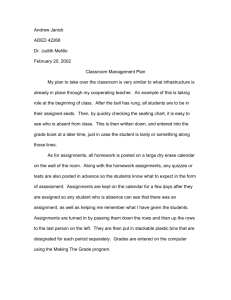Music and Mathematics: The Unexpected Duo
advertisement
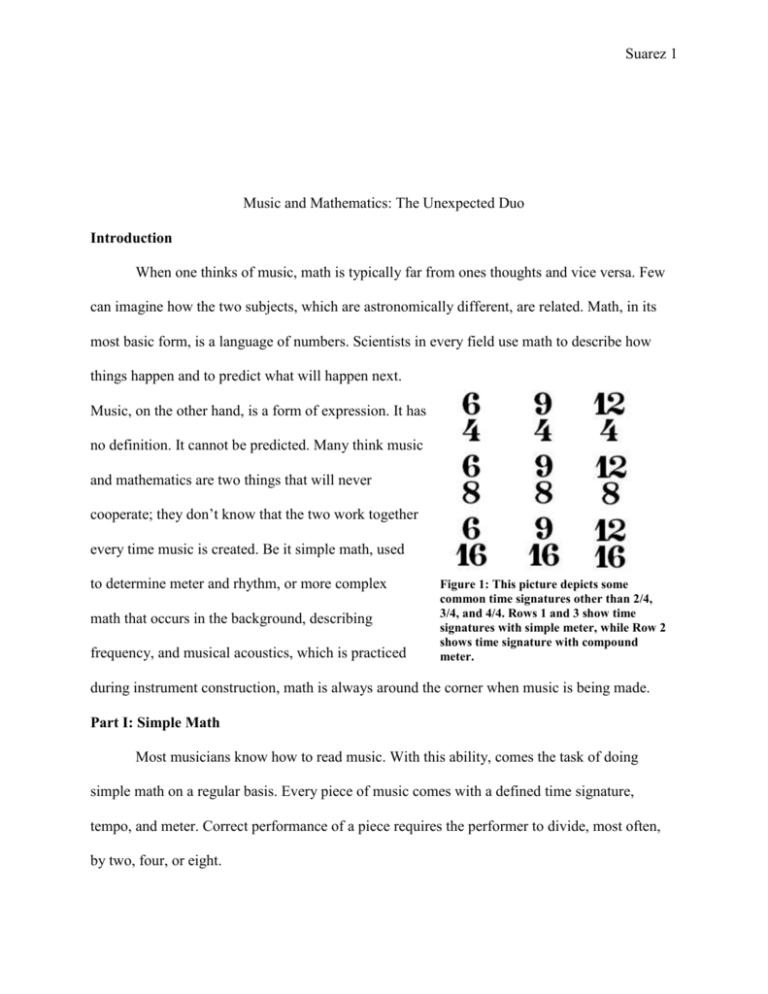
Suarez 1 Music and Mathematics: The Unexpected Duo Introduction When one thinks of music, math is typically far from ones thoughts and vice versa. Few can imagine how the two subjects, which are astronomically different, are related. Math, in its most basic form, is a language of numbers. Scientists in every field use math to describe how things happen and to predict what will happen next. Music, on the other hand, is a form of expression. It has no definition. It cannot be predicted. Many think music and mathematics are two things that will never cooperate; they don’t know that the two work together every time music is created. Be it simple math, used to determine meter and rhythm, or more complex math that occurs in the background, describing frequency, and musical acoustics, which is practiced Figure 1: This picture depicts some common time signatures other than 2/4, 3/4, and 4/4. Rows 1 and 3 show time signatures with simple meter, while Row 2 shows time signature with compound meter. during instrument construction, math is always around the corner when music is being made. Part I: Simple Math Most musicians know how to read music. With this ability, comes the task of doing simple math on a regular basis. Every piece of music comes with a defined time signature, tempo, and meter. Correct performance of a piece requires the performer to divide, most often, by two, four, or eight. Suarez 2 The time signature of a work is demonstrated at the beginning of the piece by one number stacked on top of the number, much like a fraction. The top number tells how many beats are to be counted in a measure; the most common numbers are two through twelve, while the bottom number represents the type of note that each beat represents (Study Bass). If a six is the top note of a time signature and an eight is on the bottom, then there are six eighth-notes in each measure. Meter is an element of music directly related to the time signature. Every times signature can be described as simple or compound. Simple meter means that a Figure 2: This picture shows compound and simple meters. The top line show a compound meter. The bottom line shows simple meter. beat can be divided into two notes while compound meter means that a beat can be divided into three (Ricci Adams' Musictheory.net). Tempo is the speed at which a piece of music is played and is represented by a number and is measured in bpm, or beats per minute. If the tempo is 120 bpm, then there are 120 beats in sixty seconds. The performer(s) must then measure out this speed, which in this case is two beats per second. This requires simple division of the tempo by sixty which can become slightly more complicated if the number is not divisible by sixty. Basic math is not only used in music, but it is expected. Without basic math skills, it becomes harder to interpret the notes on paper the way the composer intended. Part II: Complex Math There are more complicated and complex ways in which music and math can be intertwined with one another. Some of these include the integration of Fibonacci numbers into relationships of intervals and of the Golden Ratio, also known by the Greek symbol for Phi and is represented mathematically as Φ= 1.618033988749895...(Phi The Golden Number). They help to explain how certain notes are related to each other acoustically. Suarez 3 A sequence of numbers called Fibonacci numbers have been found to be directly related in the frequencies of notes in intervals. “Ratios found in the first seven numbers of the Fibonacci series (0, 1, 1, 2, 3, 5, 8) are related to key frequencies of musical notes” (Phi The Golden Number). The frequency of the note “A” is 440Hz. Figure 3: In this picture, Pascal’s Triangle is used to list the numbers in the Fibonacci sequence. The number in each diagonal, when added, create the list of numbers in the Fibonacci Sequence. The A one octave above it has a frequency of 880Hz and is represented by the Fibonacci Ratio 2/1. Another example is the note “C#” directly above the first A. It has a calculated frequency of 275Hz and the Fibonacci ratio 5/8 represents the relationship of its calculated frequency with the root A’s calculated frequency(Phi The Golden Number). The Golden ratio is a ratio commonly used with the Fibonacci series. It has a value of 1.618… and continues to repeat with no specific pattern (Math is Fun!) It was believed that many composers used this formula in their work. “The first movement of Mozart's Sonata No. 1 in C Major consists of 100 measures that are divided into the customary two parts; 38 in the first, 62 in the second. This ratio 38/62 (0.613) is as close as one can get to 0.618 in a composition of 100 measures” (Science Frontiers). Even complex forms of math have been found and used in music, both to explain the relationship of two notes and in music composition. They may not be necessary for its performance, but they are in use. Conclusion Though many wouldn’t expect it, many forms of math, from basic division to the Fibonacci series and the Golden Ratio, are used in the interpretation and composition of music. Composers such as Mozart, Beethoven, and Debussy appear to have used it in their own compositions and many composers still do today. Suarez 4 Works Cited "Did Mozart Use The Golden Section?" Science Frontiers Digest of Scientific Anomalies. Web. 22 Nov. 2011. <http://www.science-frontiers.com/sf107/sf107p14.htm>. "Golden Ratio." Math Is Fun - Maths Resources. Web. 22 Nov. 2011. <http://www.mathsisfun.com/numbers/golden-ratio.html>. "Music, Fibonacci Numbers and Relationships to Phi, the Golden Ratio." Phi, 1.618, the Golden Ratio and Fibonacci Series in Life, Art, Design, Beauty, Mathematics, Geometry, Stock Markets, Theology, Cosmology and More. Web. 21 Nov. 2011. <http://www.goldennumber.net/music.htm>.\ Photograph. Math Academy. Web. 26 Nov. 2011. <http://www.mathacademy.com/pr/prime/articles/fibonac/fibonac_9.gif>. Photograph. Theme & Variations. Web. 26 Nov. 2011. <http://www.siennasguidetomusic.com/Scores/compound_meter.png>. "Simple and Compound Meter." Ricci Adams' Musictheory.net. Web. 26 Nov. 2011. <http://www.musictheory.net/lessons/15>. Time Signature 15. Photograph. Making Music. Web. 26 Nov. 2011. <www.makingmusic.com/images/TimeSignature-15.jpg>. "Time Signatures." Online Bass Lessons at StudyBass.com. Web. 21 Nov. 2011. <http://www.studybass.com/lessons/reading-music/time-signatures/>.


